
The Redtoothed triggerfish is a triggerfish of the tropical Indo-Pacific area, and the sole member of its genus. Some other common names include blue triggerfish, redfang triggerfish, redtoothed filefish, and Niger triggerfish.

The filefish (Monacanthidae) are a diverse family of tropical to subtropical tetraodontiform marine fish, which are also known as foolfish, leatherjackets or shingles. They live in the Atlantic, Pacific and Indian Oceans. Filefish are closely related to triggerfish, pufferfish and trunkfish.

Amanses scopas, also known as the broom filefish, is a filefish, the only species in the genus Amanses of the family Monacanthidae. It is also called brush-sided leatherjacket in Australia or broom leatherjacket in Christmas Island.
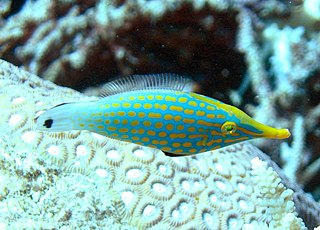
The orange spotted filefish or harlequin filefish, Oxymonacanthus longirostris, is a filefish in the family Monacanthidae found on coral reefs in the Indo-Pacific Oceans. The orangespotted filefish is a different species and refers to Cantherhines pullus.

A spongivore is an animal anatomically and physiologically adapted to eating animals of the phylum Porifera, commonly called sea sponges, for the main component of its diet. As a result of their diet, spongivore animals like the hawksbill turtle have developed sharp, narrow bird-like beak that allows them to reach within crevices on the reef to obtain sponges.
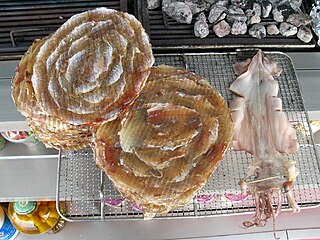
Jwipo is a traditional Korean pressed fish jerky sold as a street snack. Made from the filefish, it is seasoned, flattened, and dried. Jwichi meat has a subtle sweet flavor, but jwipo's sweetness comes from added sugar. It is traditionally served hot, heated on a burner until it curls.

Aluterus schoepfii, the orange filefish, is a species of fish in the family Monacanthidae. The species can also be listed under the family Balistidae. They can reach a maximum size of 62 centimetres (24 in) although they are common to 40 centimetres (16 in).
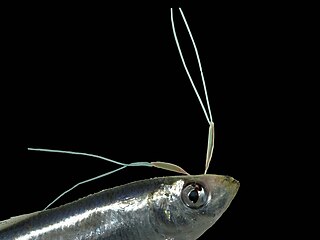
Pennellidae is a family of parasitic copepods. When anchored on a host, they have a portion of the body on the outside of the host, whereas the remaining anterior part of the parasite is hidden inside tissues of the host.

Stephanolepis cirrhifer, commonly known as the thread-sail filefish, is a species of marine fish in the family Monacanthidae. It is found in the western Pacific, in an area that ranges from northern Japan to the East China Sea, to Korea. Other common names for the fish include kawahagi (カワハギ,皮剥) (Japanese) and “쥐치” "Jwi-chi" (Korean). The fish grows to a maximum length of about 12 inches, and consumes both plant material and small marine organisms like skeleton shrimp. S. cirrhifer is host of the parasite Peniculus minuticaudae. Some minor genetic differentiation between S. cirrhifer born in the wild and those bred in a hatchery for consumer use has been shown. The fish is edible and sold commercially for culinary purposes in many Asian countries.

Stephanolepis hispidus, the planehead filefish, is a species of bony fish, a ray-finned fish in the family Monacanthidae.

Brachaluteres is a genus of filefish of the family Monacanthidae. The genus name "Brachaluteres" is derived from the Greek brachys and the Latin luteus. Fish of the genus occur in the tropical waters of the Western Pacific Ocean.
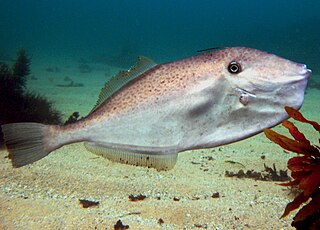
Aluterus is a genus of filefishes.
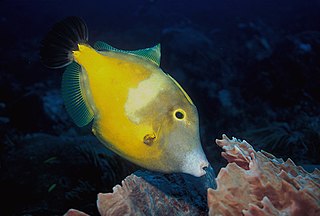
Cantherhines is a genus of filefishes.

Oxymonacanthus is a genus of filefishes native to the Indian and Pacific Oceans.
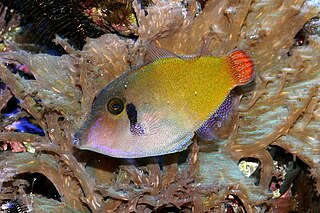
Pervagor is a genus of filefishes native to the Indian and Pacific Oceans.

Thamnaconus is a genus of filefishes native to the Indian and Pacific Oceans.

Cantherhines macrocerus, commonly known as the whitespotted filefish or American whitespotted filefish, is a marine fish found along the coast of Florida extending southward into the Caribbean. This species is distinct and separate from Cantherhines dumerilii, the similarly named whitespotted filefish which is found in the Indian and Pacific oceans.

Monacanthus ciliatus, commonly known as the fringed filefish, the cuckold or the leather-fish, is a species of bony fish commonly found in shallow water in the western Atlantic Ocean, the Caribbean Sea and the Gulf of Mexico.

Stephanolepis diaspros, commonly known as the reticulated filefish or the reticulated leatherjacket, is a species of bony fish, a ray-finned fish in the family Monacanthidae. Its natural range is the western Indian Ocean but it is also one of the species which has colonised the Mediterranean through the Suez Canal by Lessepsian migration from the Red Sea.
Mycobacterium stephanolepidis is an acid fast, rod-shaped bacteria that can form either round or smooth colonies, without pigmentation. The species name is derived from the fish that it was first discovered for infecting, Stephanolepis cirrhifer. This species grows on Middlebrook 7H11 agar or egg slants after being incubated for 3–5 days at 30 °C. Mycobacterium stephanolepidis has catalase activity and urease activity, intermediate for iron uptake. The organism fails to show Tween 80 hydrolysis, nitrate reduction, or arylsulfatase activity. It does not gro on Middlebrook 7H11 agar with picric acid. It has very little growth with 5% salt." M. stephanolepidis is "susceptible to clarithromycin, doxycycline, and ciprofloxacin." It displays either intermediate and/or resistant to the anitbiotics rifampicin, streptomycin, kanamycin and amikacin.


















